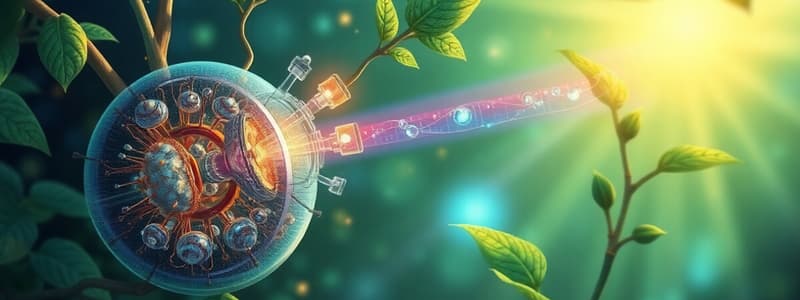Podcast
Questions and Answers
What is the main product when water undergoes photolysis in Photosystem II?
What is the main product when water undergoes photolysis in Photosystem II?
- NADPH
- Glucose
- Oxygen (correct)
- Carbon dioxide
Which complex in the photosynthetic electron transport chain is responsible for connecting Photosystem II and Photosystem I?
Which complex in the photosynthetic electron transport chain is responsible for connecting Photosystem II and Photosystem I?
- ATP synthase
- Plastocyanin
- Pheophytin
- Cytochrome b6f complex (correct)
During which light condition is cytochrome f reduced according to the provided content?
During which light condition is cytochrome f reduced according to the provided content?
- Red light (correct)
- Far-red light
- Darkness
- Blue light
What hypothesis did Mitchell propose regarding photophosphorylation?
What hypothesis did Mitchell propose regarding photophosphorylation?
What happens to the pH of the thylakoid lumen during the photosynthetic electron transport process?
What happens to the pH of the thylakoid lumen during the photosynthetic electron transport process?
What effect does adding NaOH in the presence of ADP + Pi have during the experiment conducted by Jagendorf?
What effect does adding NaOH in the presence of ADP + Pi have during the experiment conducted by Jagendorf?
What is the role of plastocyanin in the electron transport chain?
What is the role of plastocyanin in the electron transport chain?
Which protein is involved in the light reactions of photosynthesis that lacks magnesium in its structure?
Which protein is involved in the light reactions of photosynthesis that lacks magnesium in its structure?
What is the role of chlorophylls and carotenoids in photosynthesis?
What is the role of chlorophylls and carotenoids in photosynthesis?
What do the first and second Emerson effects indicate about light absorption in photosynthesis?
What do the first and second Emerson effects indicate about light absorption in photosynthesis?
What is the significance of the Z scheme in photosynthesis?
What is the significance of the Z scheme in photosynthesis?
What is the primary function of PSI during photosynthesis?
What is the primary function of PSI during photosynthesis?
Which statement correctly describes the absorption properties of PSII?
Which statement correctly describes the absorption properties of PSII?
What is one key outcome of chloroplasts oxidizing water during photosynthesis?
What is one key outcome of chloroplasts oxidizing water during photosynthesis?
What does the term 'Hill oxidant' refer to in photosynthesis?
What does the term 'Hill oxidant' refer to in photosynthesis?
How is the term ‘chemical (redox) energy’ described in the context of the reaction centre?
How is the term ‘chemical (redox) energy’ described in the context of the reaction centre?
Study Notes
Photosynthesis Overview
- Photosynthesis is the process of converting light energy into chemical energy.
- Chlorophylls and carotenoids form antenna complexes that harvest and transfer light energy to chlorophylls at the reaction centre.
- The reaction centre is where light energy is converted into chemical energy.
Photosystems
- There are two main photosystems: Photosystem I (PSI) and Photosystem II (PSII).
- PSI absorbs maximally at 700 nm (far-red light).
- PSII absorbs maximally at 680 nm (red light).
The Emerson Effects
- The first Emerson effect, also known as the "Red Drop", shows that photosynthetic efficiency decreases at wavelengths longer than 680nm.
- The second Emerson effect, also known as "Enhancement", shows that O2 production is increased when chloroplasts are illuminated with both 650nm and 700nm light simultaneously.
The Z-Scheme
- PSI and PSII operate in series, creating a "Z-scheme" of electron transport:
- PSII is a strong oxidant, oxidizing water to produce O2 and H+.
- PSI is a strong reductant, reducing NADP+ to NADPH.
- This process is called non-cyclic photophosphorylation.
Components of the Electron Transport Chain
- The electron transport chain includes:
- Cytochrome b6/f complex
- Plastocyanin (a blue copper protein)
Photolysis
- Photolysis is the process of water splitting in PSII, generating oxygen.
- Pheophytin, a chlorophyll molecule lacking Mg2+, plays a role in this process.
Photophosphorylation
- Photophosphorylation is the process of ATP generation driven by the light reactions.
- The chemiosmotic hypothesis, proposed by Mitchell, explains how a proton gradient across the thylakoid membrane drives ATP synthesis.
- Jagendorf demonstrated that a pH gradient across the thylakoid membrane, created in the dark, can drive ATP synthesis.
- The PS electron transport chain causes alkalization of the stroma and acidification of the thylakoid lumen.
- This pH gradient, along with the electron transport chain, provides the driving force for ATP synthesis.
Key Points
- The thylakoid membrane is impermeable to protons.
- The generation of a proton gradient across the membrane powers ATP synthesis.
Studying That Suits You
Use AI to generate personalized quizzes and flashcards to suit your learning preferences.
Related Documents
Description
Explore the intricate processes of photosynthesis, including the roles of chlorophyll, the two main photosystems, and the Emerson effects. Understand how light energy is converted into chemical energy through the Z-scheme of electron transport. This quiz covers essential concepts of photosynthetic efficiency and mechanisms.




